A Buddhist Peace Pagoda Rises in Washington
To Quell the Threat of Nuclear Weapons
Written by: Glen Milner
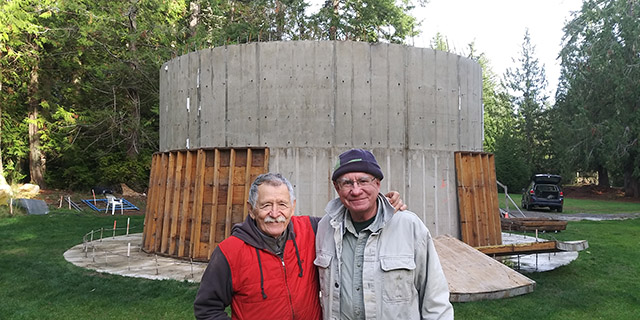
Peace Pagoda builders Denny Moore and Jim Lyman, rejoicing in completion of the second inner cylinder of the rising pagoda.
Photos by: Senji Kanaeda, Thomas Matsuda, Glen Milner, Tom Rogers
A new incarnation of the Pacific Northwest Peace Pagoda is rising on the shores of Washington state’s Hood Canal, just a few hundred feet from the largest concentration of deployed nuclear weapons in North America.
Construction of the pagoda, supported by Nipponzan Myohoji Buddhists monks, has steadily progressed over the past two years.
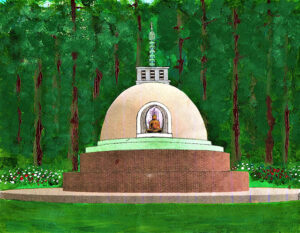
Peace Pagoda image by Senji Kanaeda, August 2019.
The Pacific Northwest Peace Pagoda is a Buddhist stupa that seeks to unite all sentient beings, regardless of race, creed or nationality, in the universal aspiration for genuine world peace.
The Peace Pagoda is inspired by traditional stupa designs, reflecting the original Indian style of a dome-shaped building topped by a spire. It will be approximately 32 feet in diameter at the base and about 30 feet tall. As with many stupas built since the time of Buddha Shakyamuni, the Peace Pagoda will entomb relics of the Buddha.
When completed, the Pacific Northwest Peace Pagoda will stand at nearly the exact location as an earlier pagoda started in 1982 on property owned by Ground Zero Center for Nonviolent Action. That pagoda was later stopped by the Kitsap County Board of Commissioners.
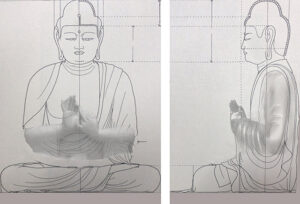
A drawing of the planned Peace Pagoda Buddha sculpture by Thomas Matsuda, utilizing elements from different statues.
The Peace Pagoda is rising about 110 feet from the property line of Naval Base Kitsap-Bangor, currently the location of eight Trident nuclear missile submarines. This is the largest concentration of deployed nuclear weapons in the United States.
Beyond supporting a movement against nuclear weapons, the Peace Pagoda will help people find their spiritual selves, to grow and connect with their Buddha nature. When people connect with their Buddha nature, they will stop the deployment of nuclear weapons.
In June 1982 The Most Venerable Nichidatsu Fujii, founder and preceptor of the Nipponzan Myohoji Order, described why the site was selected.
“The place constitutes a front-line base for U.S. nuclear weapons,” he said. “People held rallies here so that the nuclear weapons will be rendered non-operational. We have devised a plan to build a Buddhist pagoda here, to achieve the goals of the anti-nuclear campaign.”
Fujii believed a Peace Pagoda at the Ground Zero site could end the possibility of nuclear war.
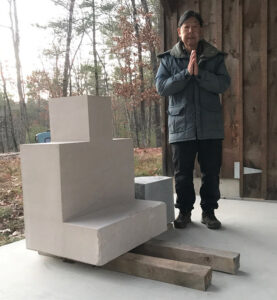
Sculptor Thomas Matsuda with the stone for the Buddha sculpture, at his studio in Leverett, Massachusetts.
Vietnamese master Thich Nhat Hanh, in “Opening the Heart of the Cosmos: Insights on the Lotus Sutra,” said,
“You are already a Buddha in the ultimate dimension, and you can become a Buddha in the historical dimension. Buddha nature, the nature of enlightenment and love, is already within you; all you need to do is get in touch with it and manifest it.”
Nichidatsu Fujii said “Our true nature is exactly equal to Buddha’s.”
The key to peace is within us all—and on both sides of the fence—at Naval Base Kitsap-Bangor and at Ground Zero Center for Nonviolent Action.
Current work on the peace pagoda is progressing in a much-more supportive atmosphere than in 1982.
The Kitsap County Department of Community Development approved the Peace Pagoda building permit on May 17, 2019. Three months later the ground purification ceremony was held in Poulsbo, Washington.
Much of the Peace Pagoda site work was completed by the end of 2019, ahead of heavy winter rain.
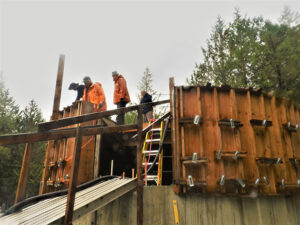
Workers pouring the upper half of the stupa inner cylinder on October 20, 2021.
By March 2020, a pipe was set in concrete at the precise center of the Peace Pagoda site, and eight months later the concrete foundation was poured.
Ten volunteers collaborated with concrete workers on July, 13, 2021, to pour the lower half of the Peace Pagoda cylinder. Eight visitors watched the pour, on a beautiful and sunny day.
By September Kitsap County had approved all pending inspection items, and waived further inspections until completion.
Then on a wet and rainy October, another five volunteers worked with concrete workers to pour the upper half of the pagoda cylinder.
During the same period Rev. Senji Kanaeda worked with Thomas Matsuda, an artist and stone carver in Leverett, Massachusetts, to finalize design of the Buddha sculpture that will be installed in the Peace Pagoda.
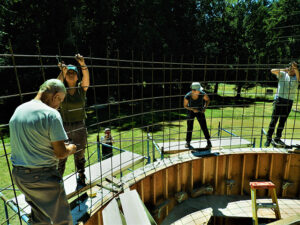
Students and instructors from IslandWood, an environmental education nonprofit on Bainbridge Island, helped with construction three times.
The sculpture will be of the Buddha giving his first preaching at Sarnath (Deer Park) in India. The hand gesture (mudra) is called the Dharmachakra Mudra, the gesture of teaching.
Buddha images use hand gestures like a sign language. These gestures, called insos in Japanese or Chinese and mudras in Sanskrit, refer to the real existence and meaning of Buddha, bodhisattvas, and Hindu gods.
Matsuda, who lived in Japan for 12 years and studied under renowned Buddhist sculptor Koukei Eri, is sculpting the statue from high-quality Indiana Limestone.
“I am constantly striving to realize a synthesis of East and West,” Matsuda said.
His teacher Eri has pointed to the unique qualities of dharma sculpture.
“In the West sculpture, like most forms of art, is viewed as a medium of artistic self-expression,” he said. “With Buddhist sculpture, however… what is important is for the artist to devote himself wholeheartedly to his task in an attitude of benevolence. That’s why you will find no signature or seal on a Buddhist image.”
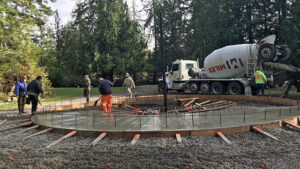
Pouring the Peace Pagoda foundation on Oct. 23, 2020.
During construction the Peace Pagoda site has been kept in immaculate condition, with newly planted grass and neatly-kept grounds. About these standards volunteer Jim Lyman, who is contributing a lifetime of construction expertise and his own labor to the Peace Pagoda project, said,
“The construction of the Peace Pagoda is a prayer unto itself, and every facet of the project is to be treated with the utmost care and respect.”
Lyman met Nichidatsu Fujii when Fujii visited the site in the early ‘80s.
The next phase of the Peace Pagoda will be the challenging task of building forms for the pagoda’s concrete dome. The dome is to be poured in March 2022.
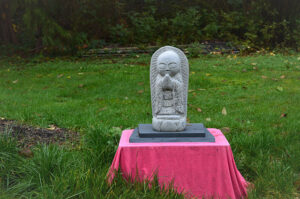
This Jizo sculpture, carved by Thomas Matsuda, watches over Peace Pagoda and workers.
It is our greatest wish that the presence of the Pacific Northwest Peace Pagoda will grow in the hearts of all peace-loving people in the U.S. and across the planet. Please join us when you are able, to walk the site, pray and meditate, or to work to build the Peace Pagoda.
Please contact Rev. Kanaeda at kanaedasenji@gmail.com or (206) 724-7632 at the Nipponzan Myohoji Bainbridge Island Temple, or Ground Zero Center for Nonviolent Action at info@gzcenter.org or (360) 930-8697.
On June 16, 1982, after his second visit to Ground Zero and at the dedication ceremony of the Nipponzan Myhoji Dojo on Bainbridge Island, The Most Venerable Nichidatsu Fujii said,
“NA-MU MYO-HO-REN-GE-KYO. …a spiritual movement of religious people must rise. This is what we call ‘non-violence,’ a movement for which no one needs to take another’s life, but should rather practice compassion, and prevent others from plotting to take life.
“For the sake of this nonviolent movement, the people of the world must come to possess one heart, one mind, and combine their strengths together to liberate humanity from the threat of annihilation.”
Glen Milner lives in Lake Forest Park and is a member of Ground Zero Center for Nonviolent Action. He identifies with the Society of Friends.
